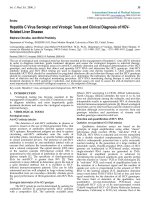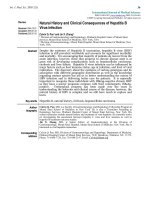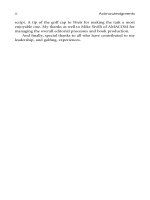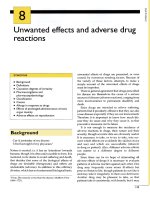Toxicology and Clinical Pharmacology of Herbal Products pdf
Bạn đang xem bản rút gọn của tài liệu. Xem và tải ngay bản đầy đủ của tài liệu tại đây (1.24 MB, 433 trang )
Page i
Toxicology and Clinical Pharmacology of Herbal Products
Page ii
Forensic Science and Medicine
Steven B. Karch, MD, S
ERIES
E
DITOR
T
OXICOLOGY
AND
C
LINICAL
P
HARMACOLOGY
OF
H
ERBAL
P
RODUCTS,
edited by Melanie Johns Cupp, 2000
CRIMINAL POISONING: INVESTIGATIONAL GUIDE FOR LAW ENFORCEMENT,
T
OXICOLOGISTS,
F
ORENSIC
S
CIENTISTS,
AND
A
TTORNEYS,
by John H. Trestrail, III, 2000
A PHYSICIAN'S GUIDE TO CLINICAL FORENSIC MEDICINE,
edited by Margaret M. Stark, 2000
Page iii
Toxicology and Clinical Pharmacology of Herbal Products
Edited by
Melanie Johns Cupp, PHARMD, BCPS
West Virginia University
Morgantown, WV
Humana Press Totowa, New Jersey
Page iv
© 2000 Humana Press Inc.
999 Riverview Drive, Suite 208
Totowa, New Jersey 07512
All rights reserved. No part of this book may be reproduced, stored in a retrieval system, or transmitted
in any form or by any means, electronic, mechanical, photocopying, microfilming, recording, or
otherwise without written permission from the Publisher.
The content and opinions expressed in this book are the sole work of the authors and editors, who have
warranted due diligence in the creation and issuance of their work. The publisher, editors, and authors
are not responsible for errors or omissions or for any consequences arising from the information or
opinions presented in this book and make no warranty, express or implied, with respect to its contents.
Due diligence has been taken by the publishers, editors, and authors of this book to assure the accuracy
of the information published and to describe generally accepted practices. The contributors herein have
carefully checked to ensure that the drug selections and dosages set forth in this text are accurate and in
accord with the standards accepted at the time of publication. Notwithstanding, as new research,
changes in government regulations, and knowledge from clinical experience relating to drug therapy
and drug reactions constantly occurs, the reader is advised to check the product information provided by
the manufacturer of each drug for any change in dosages or for additional warnings and
contraindications. This is of utmost importance when the recommended drug herein is a new or
infrequently used drug. It is the responsibility of the treating physician to determine dosages and
treatment strategies for individual patients. Further it is the responsibility of the health care provider to
ascertain the Food and Drug Administration status of each drug or device used in their clinical practice.
The publisher, editors, and authors are not responsible for errors or omissions or for any consequences
from the application of the information presented in this book and make no warranty, express or
implied, with respect to the contents in this publication.
This publication is printed on acid-free paper.
ANSI Z39.48-1984 (American Standards Institute) Permanence of Paper for Printed Library Materials.
Cover design by Patricia F. Cleary.
For additional copies, pricing for bulk purchases, and/or information about other Humana titles, contact
Humana at the above address or at any of the following numbers: Tel: 973-256-1699; Fax: 973-256-
8341;
E-mail: , or visit our Website at www.humanapress.com
Photocopy Authorization Policy:
Authorization to photocopy items for internal or personal use, or the internal or personal use of specific
clients, is granted by Humana Press Inc., provided that the base fee of US $10.00 per copy, plus US
$00.25 per page, is paid directly to the Copyright Clearance Center at 222 Rosewood Drive, Danvers,
MA 01923. For those organizations that have been granted a photocopy license from the CCC, a
separate system of payment has been arranged and is acceptable to Humana Press Inc. The fee code for
users of the Transactional Reporting Service is: [0-89603-791-6/00 $10.00 + $00.25].
Printed in the United States of America. 10 9 8 7 6 5 4 3 2 1
Library of Congress Cataloging in Publication Data
Toxicology and clinical pharmacology of herbal products / edited by Melanie Johns Cupp.
p. ; cm.—(Forensic science and medicine)
Includes bibliographical references and index.
ISBN 0-89603-791-6 (alk. paper)
1. Herbs—Toxicology. 2. Materia medica, Vegetable—Toxicology. I. Title:Herbal
products. II. Cupp, Melanie Johns. III. Series.
[DNLM: 1. Herbs adverse effects. 2. Plants, Medicinal adverse effects. 3.
Pharmacology. QV 767 T755 2000]
RA 1250 .T68 2000
615.9'52—dc21
99-046505
Page v
FOREWORD
The herbal medicine industry is growing at an astounding rate. Trade group estimates suggest that total
sales exceeded $4 billion dollars in 1999. Herbal remedies are for sale not just in health food stores, but
in supermarkets, drug stores, and even discount warehouses. Along with the proliferation in sales has
come a proliferation of information sources. Not all of the sources are equally reliable, or even
intelligible. Traditional herbalists classify thistle and mugwort as "cholagogues," substances used to
make the gallbladder contract and release bile. Medical school graduates are unlikely to have ever heard
the term, or even accept the notion that most right-sided abdominal pain is a result of diminished bile
flow.
Heroin and cocaine may not be the only drugs to come from plants, but a practicing physician or
toxicologist might be forgiven for thinking so. In 1998, 1264 papers were published about cocaine and
only 17 about kava kava, an abused herb that is not without toxic side effects. Unfortunately, the
majority of the papers about kava kava were published in journals not found in ordinary hospital
libraries. In recognition of this fact, and of the obvious need for a reliable reference work on herbal
toxicology, The Toxicology and Clinical Pharmacology of Herbal Products
was an early addition to our
new series in Forensic Science and Medicine. It is very badly needed.
The reason that herbalists and physicians use different terminology, and the reason that most herbal
medicine books are of little use to the physician confronted with a desperately ill patient, is that
herbalists and traditional physicians think about diseases (and the medicines used to treat them)
differently. Of course many of the drugs first used in modern medicine are extracted from plants. But
herbalists use whole plants and traditional physicians use purified ingredients derived from plants.
Traditional physicians and scientists generally believe that, if a plant has any medicinal value at all, it is
because it con-
Page vi
tains one "active" ingredient that must be isolated and purified. Herbalist believe results are better when
the whole herb is used, because different components of the plant act synergistically.
There are risks and benefits to both approaches. If an "active" ingredient is isolated, then it can be given
in a more concentrated form. This means that the effects, both therapeutic and toxic, will be
exaggerated. On the other hand, if the whole plant (or leaves, or roots, depending on the plant) is used,
the concentration of the active ingredient may or may not be sufficient to produce the desired
therapeutic result, but the chances for toxicity are decreased. The low concentration of active
ingredients may explain why, given the enormous numbers of people taking herbal products, relatively
few toxic reactions have been reported. Coca leaf is a good example. Indians who chew the leaves never
achieve blood cocaine concentrations high enough to produce serious toxicity. But the results of recent
studies suggest that coca leaf chewers do absorb other ingredients from the leaves that prevent high-
altitude sickness.
Herbalists also believe that combining herbs improves efficacy and reduces adverse effects. When
compounded by knowledgeable practitioners, some of the remedies do make sense. The combination of
Devil's claw, white willow, and tumeric, all agents with antiinflammatory effects, is rational, and quite
probably effective. But combining St. John's Wort, which contains a selective serotonin reuptake
inhibitor, with Ephedra, which causes increased catecholamine release, is both dangerous and ill
advised.
Whether a particular combination of herbs produces good or bad results depends on who is doing the
compounding. Under current US laws, anyone is free to market any combination of ingredients, no
matter how misguided the underlying science. Herbalists are not the only ones who combine agents. So
do patients. And they often forget to tell their physicians about it. Occassionally, this leads to dire
results. Terpenoids contained in Gingko biloba interact with platelet-activating factor. Fatal brain
hemorrhages have occurred in anticoagulated patients who self-medicated with gingko. Traditional
physicians generally avoid drugs in combination, because combinations often turn out to be
counterproductive or, as in the case of gingko, outright dangerous. For example, tetracycline and
penicillin would never be given at the same time, because the former slows bacterial growth, while the
later exerts its bactericidal effects only in growing bacteria.
Even without isolating the active principle, some herbal products are very toxic. Comfrey may be an
effective treatment for bruises and sprains, but it also contains pyrrazolidine alkaloids which can cause
severe liver damage. The alkaloid content is higher in comfrey's roots than in its leaves and higher
Page vii
in plants grown in Europe than in the United States. Yet neither the alkaloid content, the country of
origin, nor the portion of the plant used is likely to be indicated on the product label.
Dr. Cupp and her coauthors are to be congratulated for having done an excellent job in combing the
scientific literature for reliable, peer-reviewed, information about the most widely used herbal products.
They have also done a very good job in presenting that information in such a way that it is easily
accessible to practicing physicians and laboratory scientists, not to mention consumers who would be
well advised to read about any remedy, whether it is prescribed by their physician or their herbalist. The
28 subsections of this book deal with the herbs that are most often encountered. Hundreds of other
herbs exist, but reliable information about them is difficult to acquire. As more is learned, it will be
incorporated into future editions.
STEVEN B. KARCH, MD
BERKELEY, CA
Page ix
PREFACE
Sales of herbal products have increased dramatically over the past five years. Unfortunately, the
knowledge base devoted to the adverse effects of these products has not grown in proportion to their
increased usage. Data of questionable accuracy, often designed to sell products rather than to provide
objective information, can be found in the print and electronic media, most notably on the Internet.
Even in medical journals, misleading information about the beneficial and adverse effects of herbs can
be found.
Toxicology and Clinical Pharmacology of Herbal Products is designed to provide medical examiners,
toxicologists, and health care providers with an objective review of the available information on the
pharmacology and toxicology of commonly used herbs. Clinical and pathological findings from case
reports of herbal adverse effects are described in detail. Sections on the relevant pharmacokinetics,
chemical analysis, and analysis of biofluids are unique to this volume, and will be of use to pathologists
and forensic scientists, as well as to clinicians. Animal, human, and in vitro data are presented on the
known pharmacologic and toxicologic effects of each herb, arranged by organ, organ system, or
therapeutic/toxicologic effect. A good deal of pharmacology and therapeutics information is included in
this section, not only because toxicology is an extension of pharmacology, but also to make the book
useful for a wide variety of applications by professionals with various interests. Adverse effects noted
in clinical trials are noted in this section as well. At the end of the book, a summary table lists herbal
toxicities by affected organ, provides a list of herbs involved in drug interactions, and indicates the type
of data supporting the reported toxicities.
Each herbal monograph begins with a discussion of the herb's uses, products, and the dosage forms
available. This information, in conjuction with color photographs
1
of some of the most popular
products, can be of assistance in those situations where the identity of an herbal product is in question.
Page x
A chapter on the legal aspects of herbal products provides an overview of the regulation of herbal
products in the US and abroad. In addition, each herbal monograph reviews the herb's status
internationally, including approved uses.
The incidence of adverse effects associated with the use of herbal products is unknown, and may be
underreported. Without a foundation of knowledge upon which to inquire whether an herbal product
might be the cause of a given finding, further exploration of the possibility of an herb-induced toxicity
might not be undertaken. Even if an herbal product is suspected of causing an adverse outcome, without
information about similar cases, toxicological analysis of biofluids, or the pharmacologic or toxicologic
effects of the herb, further investigation might prove difficult or impossible. Toxicology and Clinical
Pharmacology of Herbal Products is designed to provide the necessary knowledge base upon which
such investigations may efficaciously proceed.
MELANIE JOHNS CUPP
1
I want to acknowledge Mark Branciaroli of Elkins, WV for producing the photographs of the herbal products.
Page xi
CONTENTS
by Steven B. Karch
Foreword
v
Preface
ix
Contributors
xxv
Product Identification Guide
following p.
134
Part I
Legal/Regulatory Aspects of Herbal Products
Melanie Johns Cupp
Chapter 1: Legal/Regulatory Aspects of Herbal Products
3
Part II
Monographs
Steven B. Karch
Chapter 1: Ma Huang and the Ephedra Alkaloids
11
1.1
Sources
11
1.2
History and Traditional Uses
11
1.3
Current Promoted Uses
12
1.4
Available Products
13
1.5
Pharmacology
15
1.5.1
Introduction
15
1.5.2
Pharmacologic Effects
16
1.5.3
Metabolism and Elimination
16
1.5.4
Workplace and Sports Drug Testing
17
1.6
Drug Interactions
17
1.7
Toxicology
18
1.7.1
Neurologic Disorders
18
1.7.2
Renal Disorders
19
1.7.3
Cardiovascular Diseases
21
1.7.4
Other Medical Problems and Effects
22
Page xii
1.8
Postmortem Toxicology
23
1.9
Analytic Considerations
24
1.10
Methamphetamine Manufacture
24
1.11
Commission E Recommendations
24
Shawn Reeder and Melanie Johns Cupp
Chapter 2: Kava
31
2.1
History and Traditional Uses
31
2.2
Current Promoted Uses
32
2.3
Products Available
32
2.4
Pharmacologic/Toxicologic Effects
32
2.4.1
Neurologic Effects
32
2.4.2
Dermatological Effects
35
2.4.3
Musculoskeletal Effects
36
2.4.4
Antimicrobial Activity
36
2.4.5
Hepatotoxicity
36
2.4.6
Antiplatelet Effects
36
2.5
Case Reports of Toxicity Due to Commercially Available Products
36
2.6
Toxicity Associated with Traditional Use by Native Populations
37
2.7
Drug Interactions
38
2.8
Pharmacokinetics/Toxicokinetics
38
2.8.1
Absorption
38
2.8.2
Metabolism/Elimination
38
2.9
Analysis of Biofluids
38
2.10
Chemical Analysis
39
2.11
Regulatory Status
39
Forouzandeh Mahdavi and Melanie Johns Cupp
Chapter 3: Ginkgo biloba
43
3.1
History and Traditional Use
43
3.2
Current Promoted Use
43
3.3
Products Available
43
3.4
Pharmacologic/Toxicologic Effects
44
3.4.1
Nervous System Effects
44
3.4.2
Cardiovascular Effects
46
3.4.3
Carcinogenicity/Mutagenicity/Teratogenicity
46
3.4.4
Endocrine Effects
47
3.5
Case Reports of Toxicity Due to Commercially Available Products
47
3.6
Drug Interactions
48
3.7
Pharmacokinetics/Toxicokinetics
48
Page xiii
3.7.1
Absorption
48
3.7.2
Distribution
49
3.7.3
Metabolism/Elimination
49
3.8
Chemical Analysis
49
3.9
Analysis of Biofluids
50
3.10
Regulatory Status
50
Marlea Givens and Melanie Johns Cupp
Chapter 4: Valerian
53
4.1
History and/Traditional Uses
53
4.2
Current Promoted Uses
53
4.3
Products Available
54
4.4
Pharmacologic/Toxicologic Effects
54
4.4.1
Central Nervous System Effects
54
4.4.2
Musculoskeletal Effects
59
4.4.3
Reproduction
59
4.4.4
Cardiovascular Effects
60
4.4.5
Cytotoxicity
60
4.5
Case Reports of Toxicity Due to Commercially Available Products
61
4.6
Drug Interactions
63
4.7
Chemical Analysis
64
4.8
Regulatory Status
64
John T. Schwarz and Melanie Johns Cupp
Chapter 5: St. John's Wort
67
5.1
History and Traditional Uses
67
5.2
Current Promoted Uses
67
5.3
Products Available
68
5.4
Pharmacologic/Toxicologic Effects
68
5.4.1
Neurological Effects
68
5.4.2
Antimicrobial Effects
70
5.4.3
Mutagenicity
70
5.4.4
Reproduction
70
5.5
Adverse Effects and Toxicity
70
5.6
Drug Interactions
72
5.7
Pharmacokinetics/Toxicokinetics
74
5.7.1
Absorption
74
5.7.2
Distribution
75
5.7.3
Metabolism/Elimination
75
5.8
Chemical Analysis
76
5.9
Analysis of Biofluids
76
5.10
Regulatory Status
76
Page xiv
Melanie Johns Cupp
Chapter 6: Chamomile
79
6.1
History and Traditional Uses
79
6.2
Current Promoted Uses
79
6.3
Products Available
79
6.4
Pharmacologic/Toxicologic Effects
79
6.4.1
Neurologic Effects
79
6.4.2
Antineoplastic Effects
80
6.4.3
Anti-Inflammatory Activity
80
6.5
Case Reports of Toxicity Due to Commercially Available Products
80
6.6
Pharmacokinetics/Toxicokinetics
82
6.7
Analysis of Biofluids
82
6.8
Regulatory Status
82
Julie Davis and Melanie Johns Cupp
Chapter 7: Echinacea
85
7.1
History and Traditional Uses
85
7.2
Current Promoted Uses
86
7.3
Products Available
86
7.4
Pharmacologic/Toxicologic Effects
86
7.4.1
Immunologic Effects
86
7.4.2
Antimicrobial/Antiviral Effects
87
7.4.3
Antineoplastic Activity
89
7.4.4
Wound-Healing
89
7.4.5
Anti-Inflammatory Effects
90
7.4.6
Mutagenicity/Carcinogenicity
90
7.4.7
Reproduction
90
7.5
Case Reports of Toxicity Due to Commercially Available Products
90
7.6
Chemical Analysis
91
7.7
Regulatory Status
91
Brian Schuller and Melanie Johns Cupp
Chapter 8: Feverfew
95
8.1
History and Traditional Uses
95
8.2
Current Promoted Uses
95
8.3
Products Available
96
8.4
Pharmacology/Toxicology
97
8.4.1
Neurologic Effects
97
8.4.2
Anti-Inflammatory Effects
100
8.4.3
Mutagenicity/Carcinogenicity/Teratogenicity
101
Page xv
8.5
Case Reports of Toxicity Due to Commercially Available Products
102
8.6
Drug Interactions
102
8.7
Chemical Analysis
103
8.8
Regulation
103
James Allman and Melanie Johns Cupp
Chapter 9: Garlic
107
9.1
History and Traditional Uses
107
9.2
Current Promoted Uses
107
9.3
Products Available
107
9.4
Pharmacologic/Toxicologic Effects
109
9.4.1
Cardiovascular Effects
109
9.4.2
Gastrointestinal Effects
112
9.4.3
Antimicrobial Activity
112
9.4.4
Antineoplastic Effects
113
9.4.5
Immunostimulant Effects
114
9.5
Case Reports of Toxicity
115
9.6
Drug Interactions
118
9.7
Pharmacokinetics/Toxicokinetics
118
9.7.1
Absorption
118
9.7.2
Distribution
118
9.7.3
Metabolism/Elimination
118
9.8
Analysis of Biofluids
120
9.9
Regulatory Status
120
Charity Metz and Melanie Johns Cupp
Chapter 10: Ginger
123
10.1
History and Traditional Uses
123
10.2
Current Promoted Uses
124
10.3
Products Available
124
10.4
Pharmacologic/Toxicologic Effects
125
10.4.1
Gastrointestinal Effects
125
10.4.2
Anti-Inflammatory Activity
126
10.4.3
Use in Migraine
127
10.4.4
Cardiovascular Effects
127
10.4.5
Mutagenicity
128
10.4.6
Reproduction
128
10.5
Case Reports of Toxicity Due to Commercially Available Products
128
10.6
Drug Interactions
129
10.7
Chemical Analysis
129
10.8
Regulatory Status
129









